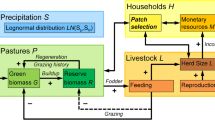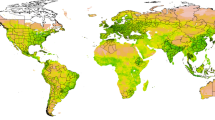Abstract
Demographic and socioeconomic factors of individual people and households may have significant impacts on their environment, which in turn may affect the spatio-temporal dynamics of wildlife habitat and local biodiversity. In the Wolong Nature Reserve (China) for giant panda conservation, local households live a rural lifestyle that has caused forest degradation by activities such as cutting fuelwood. Based on field data and a spatial agent-based model that integrates cross-scale data and cross-discipline models, we examine how panda habitat would respond to changes in a set of socioeconomic and demographic factors individually, and under a conservation scenario and a development scenario (setting factors to values that would benefit or degrade habitat, respectively). The model simulates each family member’s life history (including needs, attitudes, and activities) and the household agents’ interactions with each other and with the environment through their activities over 30 years. Our simulations show that among all the factors under consideration, providing cheaper electricity and changing the age structure through increasing marriage age or prolonging the interval between consecutive births could change habitat quantity significantly (at α = 0.05 level); and the differences in panda habitat between the two scenarios escalate over time. In addition to benefiting local policy-making, this study provides a new approach to studying human-environment interactions from the perspectives of individual needs and decisions.
Access this chapter
Tax calculation will be finalised at checkout
Purchases are for personal use only
Preview
Unable to display preview. Download preview PDF.
Similar content being viewed by others
References
An L., Liu J., Ouyang Z., Linderman M.A., Zhou S. and Zhang H. 2001. Simulating demographic and socioeconomic processes on household level and implications on giant panda habitat. Ecol. Model. 140: 31–49.
An L., Linderman M.A., Qi J., Shortridge A. and Liu J. 2003b An agent-based spatial model for interdisciplinary and across-scale integration. Ann. Assoc. Am. Geogr. (in review).
An L., Lupi F., Liu J., Linderman M.A. and Huang J. 2002. Modeling the choice to switch from fuelwood to electricity: implications for giant panda habitat conservation. Ecol. Econ. 42(3): 445–457.
An L., Mertig A. and Liu J. 2003a. Adolescents’ leaving parental home: psychosocial correlates and implications for biodiversity conservation. Popul. Environ.: J. Interdiscipl. Stud. 24(5): 415–444.
Axinn W.G. and Barber J.S. 2003. Linking people and land use. In: Fox J., Rindfuss R.R., Walsh S.J. and Mishra V. (eds), People and the Environment: Approaches for Linking Household and Community Surveys to Remote Sensing and GIS. Kluwer Academic Publishers, Boston, pp. 285–313.
Clark W.C. 2002. Research systems for a transition toward sustainability. In: Steffen W., Jäger J., Carson D. and Bradshaw C. (eds), Challenges of a Changing Earth, Proceedings of the Global Change Open Science Conference, Amsterdam, NL, 10–13 July 2001. Springer-Verlag, Berlin. http://ksgnotes1.harvard.edu/BCSIA/sust.nsf/pubs/pub54.
Cooney R.S. and Shi J. 1987. Household extension of the elderly in China. Popul. Res. Policy Rev. 18(5): 451–471.
Daily G.C. 1996. Socioeconomic equity, sustainability, and earth’s carrying capacity. Ecol. Appl. 6(4): 991–1001.
Ehrlich P.R. and Wilson E.O. 1991. Biodiversity studies: science and policy. Science 253: 758–762.
Feng G. and Hao L. 1992. Summary of 28 regional birth planning regulations in China. Population Res. (Renkou Yanjiu; in Chinese) 4: 28–33.
Gimblett H.R. 2002. Integrating geographic information systems and agent-based technologies for modeling and simulating social and ecological phenomena. In: Gimblett H.R. (ed.), Integrating Geographic Information Systems and Agent-Based Techniques for Simulating Social and Ecological Processes. Oxford University Press, New York, pp. 1–20.
Grimm V. 1999. Ten years of individual-based modeling in ecology: what have we learned and what could we learn in the future? Ecol. Model. 115: 129–148.
Gulyáa L. 2002. On the transition to agent-based modeling: implementation strategies from variables to agents. Soc. Sci. Comput. Rev. 20(4): 389–399.
Hussain A. 2002. Demographic transition in China and its implication. World Dev. 30(10): 1823–1834.
Jiang B. and Gimblett H.R. 2002. An agent-based approach to environmental and urban systems within geographic information systems. In: Gimblett H.R. (ed.), Integrating Geographic Information Systems and Agent-Based Techniques for Simulating Social and Ecological Processes. Oxford University Press, New York, pp. 171–189.
Klawon E. and Tiefenthaler J. 2001. Bargaining over family size: the determinants of fertility in Brazil. Popul. Res. Policy Rev. 20: 423–440.
Lambin E.F. 2003. Linking socioeconomic and remote sensing data at the community or at the household level: two case studies from Africa. In: Fox J., Rrndfuss R.R., Walsh S.J. and Mishra V. (eds), People and the Environment: Approaches for Linking Household and Community Surveys to Remote Sensing and GIS. Kluwer Academic Publishers, Boston, pp. 223–240.
Laurie A. and Pan W. 1991. Working group report on giant pandas in the wild. In: Klerman D. and Roberts M. (eds), Giant Panda and Red Panda Conservation Workshop, Working Group Reports, National Zoological Park. Smithsonian Institution, Washington, DC, pp. 5–12.
Liang Z. 2001. The age of migration in China. Popul. Dev. Rev. 27(3): 499–524.
Liang Z. and Ma Z. China’s floating population: new evidence from the 2000 census. Population and Development Review. (in press).
Lim K., Deadman P.J., Moran E., Brondizio E. and McCracken S. 2002. Agent-based simulations of household decision-making and land use change near Altamira, Brazil. In: Gimblett H.R. (ed.), Integrating Geographic Information Systems and Agent-Based Techniques for Simulating Social and Ecological Processes. Oxford University Press, New York, pp. 277–308.
Liu J. 2001. Integrating ecology with human demography, behavior, and socioeconomics: needs and approaches. Ecol. Model. 140(1–2): 1–8.
Liu J, Daily G.C., Ehrlich P.R. and Luck G.W. 2003. Effects of household dynamics on resource consumption and biodiversity. Nature 421(6922): 530–533.
Liu J., Linderman M., Ouyang Z., An L., Yang J. and Zhang H. 2001. Ecological degradation in protected areas: the case of Wolong Nature Reserve for giant pandas. Science 292: 98–101.
Liu J., Ouyang Z., Tan Y., Yang J. and Zhang H. 1999a. Changes in human population structure: implications for biodiversity. Popul. Environ.: J. Interdiscipl. Stud. 21: 46–58.
Liu J., Ouyang Z., Taylor W.W., Groop R. and Zhang H. 1999b. A framework for evaluating the effects of human factors ob wildlife habitat: the case of giant pandas. Conserv. Biol. 13: 1360–1370.
Malthus T.R. 1798. An essay on the principle of population it affects the future improvement of society. Reprint, Pelican Books (1970). Harmondsworth, England.
Merli M.G. and Smith M.L. 2002. Has the Chinese family planning policy been successful in changing fertility preferences? Demography 39(3): 557–572.
Oreskes N., Shrader-Frechette K. and Belitz K. 1994. Verification, validation, and confirmation of numerical models in the earth sciences. Science 263(5147, Feb. 4, 1994): 641–646.
Pebley A.R. 1998. Demography and the environment. Demography 35(4): 377–389.
Perz S.G. 2001. Household demographic factors as life cycle determinants of land use in the Amzon. Popul. Res. Policy Rev. 20: 159–186.
Rykiel E.I. Jr. 1996. Testing ecological models: the meaning of validation. Ecol. Model. 90(1996): 229–244.
Schaller G.B., Hu J., Pan W. and Zhu J. 1985. The Giant Pandas of Wolong. The University of Chicago Press, Chicago and London.
Schultz T.P. 1981. Economics of Population. Addison-Wesley, Reading, Massachusetts.
Sushama P.N. 1996. Transition from high to replacement-level fertility in a Kerala village. Health Trans. Rev. 6: 115–136.
Turner B.L. (ed.) 1990. The Earth As Transformed by Human Action: Global and Regional Changes in the Biosphere over the Past 300 Years. Cambridge University Press, Cambridge and New York.
United States National Research Council Boardon Sustainable Development. 1999. Our Common Journey: A Transition Toward Sustainability. National Academy Press, Washington, DC.
Wilson E.O. 1988. The current state of biological diversity. In: Wilson E.O. (ed.), Biodiversity. National Academy Press, Washington, DC.
Wolong Nature Reserve. 1987. Wolong Vegetation Cover and Plant Resources. Sichuan Science and Technology Press, Chengdu (China).
Wolong Nature Reserve. 1996. Agricultural Census. Wolong (unpublished, in Chinese).
Wolong Nature Reserve. 2000. The 2000 Nationwide Population Census. Wolong (unpublished, in Chinese).
Wong J. 2001. China’s sharply declining fertility: implications for its population, policy. Issues Stud. 37(3): 68–86.
Yang X. 2000. The fertility impact of temporary migration in China: a detachment hypothesis. Eur. J. Popul. 16: 163–183.
Yang Y. and Li C. (eds) 1992. Sichuan Forests. China Forestry Press, Beijing, China.
Zimmer Z. and Kwong J. 2003. Family size and support of old adults in urban and rural China: current effects and future implications. Demography 40(1): 23–44.
Author information
Authors and Affiliations
Editor information
Rights and permissions
Copyright information
© 2006 Springer
About this chapter
Cite this chapter
An, L., He, G., Liang, Z., Liu, J. (2006). Impacts of demographic and socioeconomic factors on spatio-temporal dynamics of panda habitat. In: Hawksworth, D.L., Bull, A.T. (eds) Human Exploitation and Biodiversity Conservation. Topics in Biodiversity and Conservation, vol 3. Springer, Dordrecht. https://doi.org/10.1007/978-1-4020-5283-5_2
Download citation
DOI: https://doi.org/10.1007/978-1-4020-5283-5_2
Received:
Accepted:
Publisher Name: Springer, Dordrecht
Print ISBN: 978-1-4020-5282-8
Online ISBN: 978-1-4020-5283-5
eBook Packages: Biomedical and Life SciencesBiomedical and Life Sciences (R0)




